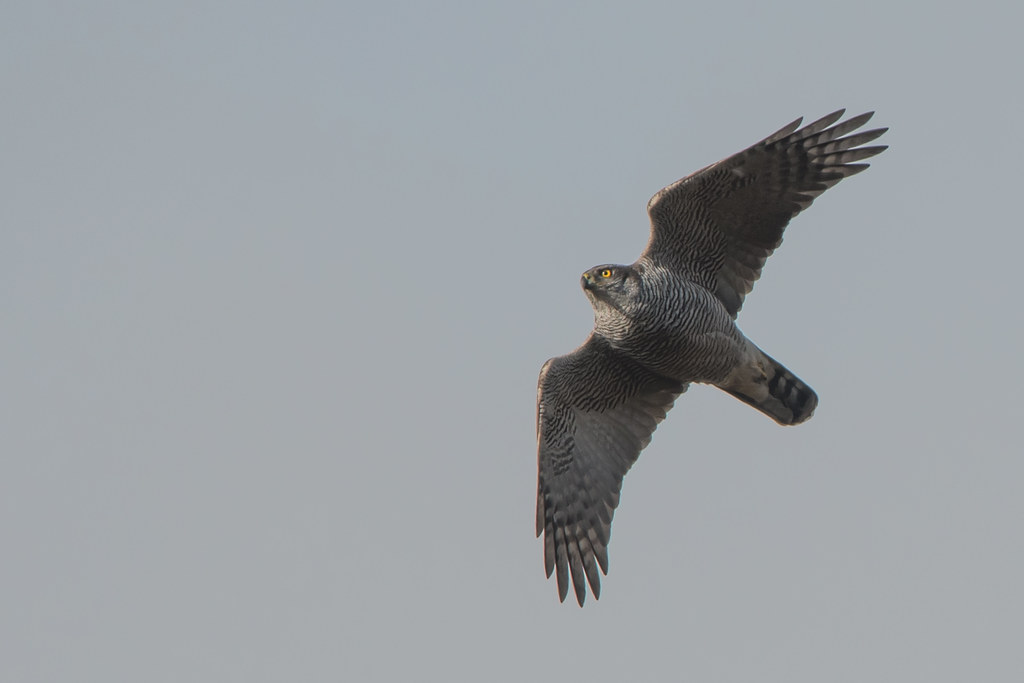
Tim writes: I was out on the Peak District Moors in early March and had a great stroke of luck when this female Goshawk cruised over me. I identified her as a female by her large size, but also by the rather indistinct face pattern and yellow eye. Males are smaller with a noticeably dark cheek and usually a fiery orange eye, though the eye becomes more orange with age. The size difference between males and females is particularly marked in Goshawks, with females weighing about 1.5kg but the smaller males only reach 0.85kg. Goshawk has proportionately longer wings than Sparrowhawk and a more protruding head, which looks smaller. Goshawk does have a heavier belly but perhaps the most diagnostic feature is the round-ended tail. Sparrowhawk has a more square-ended tail in comparison. I think that Goshawk looks plainer at the back of the wing, with no hint of a darker trailing edge, and the underpart barring is finer on Goshawk.
Goshawk was extirpated as a breeding bird in Britain towards the end of the nineteenth century. But it reappeared in 1938 and the numbers have gradually built-up to around 620 pairs today. The expansion accelerated during the 1970s, probably as a result of escaped falconers birds. The reasons why this is likely is that colonisation started in the west rather than the east. In addition the European population was at a low ebb at this time due to pesticide effects. British birds were larger than those in adjacent areas of Scandinavia, and finally, several early colonisers were wearing jesses or bells. Goshawks have always been popular birds for falconry because they can be launched from the wrist straight at prey.
[registration_form]
And she still had all her primaries, times are changing.
I see Goshawks here in Wales fairly regularly, although I haven’t had quite Tim’s luck with photography as they always come closer when I have the dog but no camera ( the two don’t work together well). Sparrowhawks always look, to me anyway light and flimsy, even females and darker underneath when you see Gos regularly. The bulk, rounded tail and longer wings even at some distance are the usual give away, although on two occasions at great distance I have thought birds that were Goshawks in glides were big female Peregrines. You never stop learning looking at raptors.
What a totally wonderful creature! The E-type of the Raptor world. Thanks for sharing that!
Steve Petty’s studies showed that our Gos come from a wide range of European populations – he found it was possible to identify origins from dropped feathers. I recall that, as usual, Gos get larger thevfurther north you go.
And paler the further east you go such that in A. g. albidus which is the palest race/subspecies with half the birds of this form being all white. Some claim this is also the largest form but measurements overlap with A. g. butoides ( northern Fennoscandia-west Siberia) and the largest A.g. gentilis of Europe. Despite claims to the contrary in some books A. g. atricapillus of North America is slightly smaller than the largest European birds, this form has the darkest ( almost black) crown and cheeks and the reddest eyes.
For those who have not seen Goshawk or have seen few the best times to see them in my experience are late July to October when young birds are learning to hunt and dispersing, then late November to mid March when adults display, early morning is best on breezy days with some sun. Birds display most when their nearest neighbours are within view, isolated pairs often display very little.
I’ve never seen one in all my days. Despite spending a huge amount of time in areas where they should be (yes, it’s the usual reason). But fifteen years ago I only saw a buzzard in that same same general area four or five times a year…now i can see a couple in a week. So I do live in hope, although I accept the wider population dynamic is totally different.